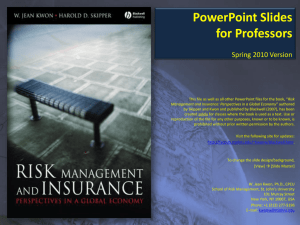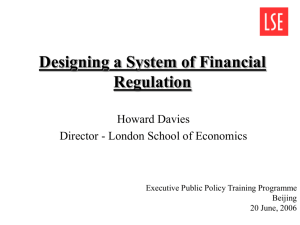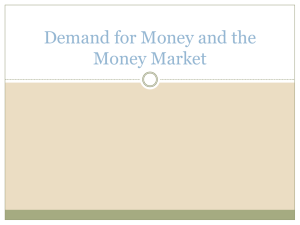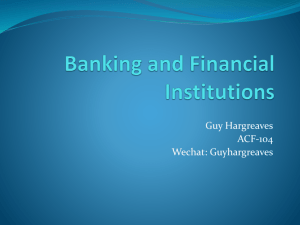Discussion 1. Gerard Caprio
advertisement
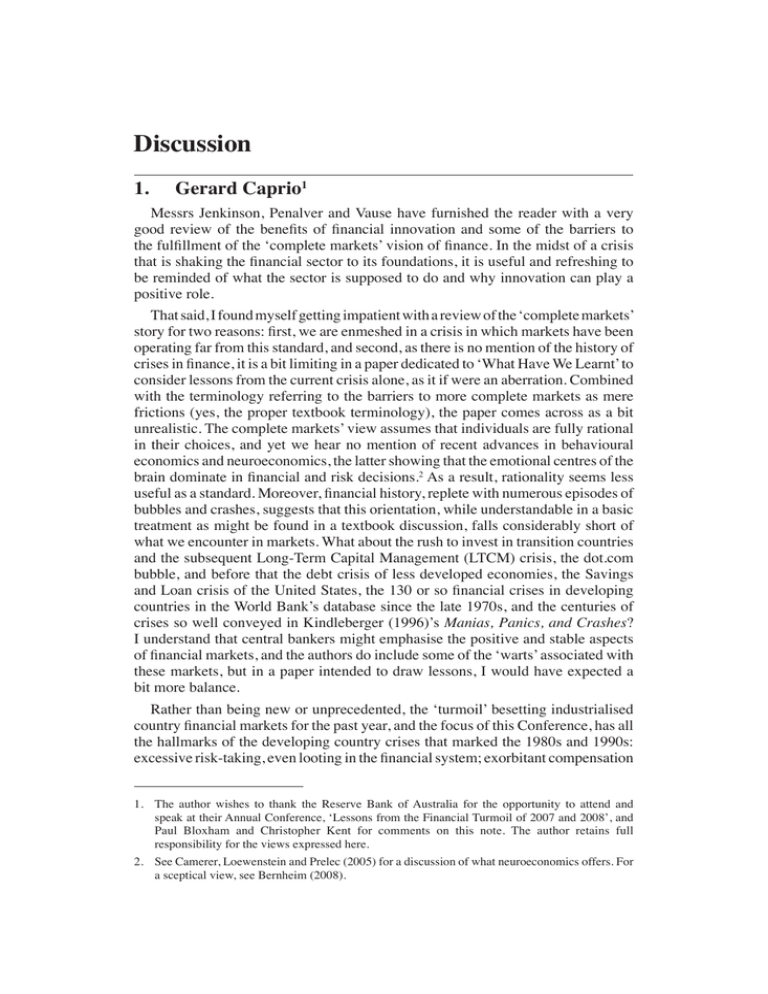
Discussion 47 Discussion 1. Gerard Caprio1 Messrs Jenkinson, Penalver and Vause have furnished the reader with a very good review of the benefits of financial innovation and some of the barriers to the fulfillment of the ‘complete markets’ vision of finance. In the midst of a crisis that is shaking the financial sector to its foundations, it is useful and refreshing to be reminded of what the sector is supposed to do and why innovation can play a positive role. That said, I found myself getting impatient with a review of the ‘complete markets’ story for two reasons: first, we are enmeshed in a crisis in which markets have been operating far from this standard, and second, as there is no mention of the history of crises in finance, it is a bit limiting in a paper dedicated to ‘What Have We Learnt’ to consider lessons from the current crisis alone, as it if were an aberration. Combined with the terminology referring to the barriers to more complete markets as mere frictions (yes, the proper textbook terminology), the paper comes across as a bit unrealistic. The complete markets’ view assumes that individuals are fully rational in their choices, and yet we hear no mention of recent advances in behavioural economics and neuroeconomics, the latter showing that the emotional centres of the brain dominate in financial and risk decisions.2 As a result, rationality seems less useful as a standard. Moreover, financial history, replete with numerous episodes of bubbles and crashes, suggests that this orientation, while understandable in a basic treatment as might be found in a textbook discussion, falls considerably short of what we encounter in markets. What about the rush to invest in transition countries and the subsequent Long-Term Capital Management (LTCM) crisis, the dot.com bubble, and before that the debt crisis of less developed economies, the Savings and Loan crisis of the United States, the 130 or so financial crises in developing countries in the World Bank’s database since the late 1970s, and the centuries of crises so well conveyed in Kindleberger (1996)’s Manias, Panics, and Crashes? I understand that central bankers might emphasise the positive and stable aspects of financial markets, and the authors do include some of the ‘warts’ associated with these markets, but in a paper intended to draw lessons, I would have expected a bit more balance. Rather than being new or unprecedented, the ‘turmoil’ besetting industrialised country financial markets for the past year, and the focus of this Conference, has all the hallmarks of the developing country crises that marked the 1980s and 1990s: excessive risk-taking, even looting in the financial system; exorbitant compensation 1. The author wishes to thank the Reserve Bank of Australia for the opportunity to attend and speak at their Annual Conference, ‘Lessons from the Financial Turmoil of 2007 and 2008’, and Paul Bloxham and Christopher Kent for comments on this note. The author retains full responsibility for the views expressed here. 2. See Camerer, Loewenstein and Prelec (2005) for a discussion of what neuroeconomics offers. For a sceptical view, see Bernheim (2008). 48 Discussion of financial market participants relative to average incomes; extreme information asymmetries and faulty accounting and auditing, to the point that much information is suspect; collapsing asset prices; and sharp questioning of regulatory officials. In short, these were a number of the hallmarks of what was labeled as ‘crony capitalism’ during the east Asian crisis. Ironically, developing country officials have been moving in recent years to adopt industrialised country best practice, and now must be asking themselves about the appropriate standard. To be sure, the authors do discuss some of the problems that may have caused the recent crisis, notably the loss of information that was part of the securitisation process. The explanation is accurate, clear, and nicely portrayed in Figure 2 of their paper on information loss, but deserves further elaboration. For example, how much diversification was achieved by omitting market risk – which in this case was mostly the risk, and even likelihood, that market interest rates could rise, increasing the defaults across the pool of securities? Was this incompetence or should it have been another issue taken up in their section on incentives? Rajan (2005) presciently noted several years ago the downside of financial innovation, and the authors might recognise this earlier on in their discussion: rather than being praised as a source of potential efficiency, the key downside, namely that the originate-to-distribute model would leave banks as agents rather than the principals in mortgage transactions, deserves more emphasis. If one views crises as endemic to finance, then one might want to think in more radical terms as to what might be done to change the way in which it is regulated. The recommendations, or suggestions, in Section 5 of the paper include some predictions (for example, ‘... products will be more transparent in design and content ... end-investors will demand more explicit rules ... [e]quilibrium liquidity premia will be higher ... banks and other financial institutions will provide more information ...’). Unfortunately, it is not clear how we will get to such eventualities. Might not one have offered the same predictions after the crash of 1987, LTCM, or the Enron/WorldCom debacle? As has been seen in financial history, markets have short memories, and the debate therefore is how we might steer the system to a different outcome. For example, can the industry reform compensation on its own and develop more robust disclosure standards (including compensation itself!), or is regulatory intervention necessary? As a model for the future, I would note that it is important to look at what works and what does not in financial regulation in practice. While certainly not immune to criticism, cross-country databases offer some lessons and a different perspective on reform. James Barth, Ross Levine and I (Barth, Caprio and Levine 2006), using a large cross-country database on bank regulation and supervision, assembled under the auspices of the World Bank, found the following in our 2006 study: • no evidence that capital regulation works to improve financial development, efficiency in financial markets, financial stability, or corruption in the financial system; • no evidence that supervision helps in any of these regards, and in fact some evidence that increasing supervisory power in a weak institutional setting can do harm; Discussion 49 • clear evidence that market discipline helps improve along the dimensions above except not in increasing financial stability; and • evidence that increasing diversification – allowing banks to engage in a broader array of financial activities – and limiting moral hazard in banking are linked to more stable banking systems. Clearly the Barth et al (2006) study does not constitute an evaluation of Basel II, which was not in effect during the late 1990s when the data in the study were collected.3 Still, in addition to the failure of models and rating agencies (linchpins of Pillar 1 of Basel II) these conclusions suggest that relying on capital and supervision Pillars 1 and 2 of the new Basel system is not likely to succeed. Barth et al suggest a new model for regulation, in which market discipline is not an afterthought, but rather plays a central role. In this model, supervisors would not be devising complex formulas for risk management (Pillar 1) or applying their judgment in regulating banks (Pillar 2), but rather would be concentrating on compelling banks to disclose information on an accurate and timely basis and handing out penalties for shortcomings in this area. In this respect, supervision would work to complement market discipline, rather than to regard market discipline as an afterthought. Moreover, there is clear evidence that a well-functioning financial system contributes to growth, and that an approach stressing market discipline supports the development of the financial sector. Requiring mandatory subordinated debt, which would confront supervisors with the markets’ views on intermediaries on a timely basis, is consistent with this approach and worthy of discussion, and certainly the current crisis suggests that much more thought is needed on the extent of disclosure and how non-banks are to be regulated. With more information, large uninsured creditors might have done more to limit the scale of risk-taking prior to the recent crisis. Although suggestions for market discipline are out of favour since the crisis started, why would one think that the current approach of increasing reliance on official supervision can be perfected? Given the resources devoted to supervision in the United States and the United Kingdom in recent years, will more resources work? In other words, rather than suggesting a laissez-faire approach, reform should recognise both market failure and government failure. Yet the latter seems far from the focus, indeed it does not appear on the radar screen of the Basel Committee on Banking Supervision. It is high time that the incentives of markets and officials receive due attention, and that the Committee returns to the drawing board. By its silence on Basel II, and by endorsing some of the recommendations of the Financial Stability Forum, the authors create the impression that modest reforms around the current regulatory model will succeed. It is more likely that finance is in for a regulatory upheaval not seen since the Depression. The current crisis, the history of crises in finance, and an examination of regulation in practice all support the utility and timeliness of such a re-examination. 3. See the World Bank website at <http://econ.worldbank.org/WBSITE/EXTERNAL/EXTDEC/ EXTRESEARCH/0,,contentMDK:20345037~pagePK:64214825~piPK:64214943~theSite: PK469382,00.html> for updates on that database (‘Bank Regulation and Supervision’). 50 Discussion References Barth JR, G Caprio and R Levine (2006), Rethinking Bank Regulation: Till Angels Govern, Cambridge University Press, New York. Bernheim BD (2008), ‘Neuroeconomics: A Sober (but Hopeful) Appraisal’, NBER Working Paper No 13954. Camerer C, G Loewenstein and D Prelec (2005), ‘Neuroeconomics: How Neuroscience Can Inform Economics’, Journal of Economic Literature, 43(1), pp 9–64. Kindleberger CP (1996), Manias, Panics, and Crashes: A History of Financial Crises, 3rd edn rev, John Wiley & Sons Inc, New York. Rajan R (2005), ‘Has Financial Development Made the World Riskier?’, NBER Working Paper No 11728. 2. Paul Bide The paper by Nigel Jenkinson, Adrian Penalver and Nicholas Vause very capably logs many features of the financial system that have contributed to the recent financial turmoil. I therefore do not want to provide a critique, but rather to discuss these issues from my own perspective: that of a financial market participant and observer. I might commence my comments by observing that in my view, it needs to be said that, in a sense that is relevant to financial markets, guns don’t kill people, people kill people. I think this line is relevant in a couple of ways. First, not every participant in the finance industry was engaged in the financially innovative segment of that industry and, second, not every participant that did engage ‘shot’ themselves. Some of the systemic and idiosyncratic issues with respect to liquidity and bank capitalisation occurred because some very old-fashioned ways of losing money were newly discovered. I also note that the financial sector is ultimately about providing financial products and services to end-users, a lot of them retail-level borrowers and lenders. Any examination of the issues needs to incorporate the products and practices of the whole system. Moreover, it is the behavioural features of that system which determine how free will manifests itself in markets. If there has been unwanted excess in markets then by definition, people – regulators, legislators, policy-makers, bankers and financial markets professionals, and financial ‘civilians’ – have all been part of those excesses. For instance, with respect to the United States, the right kind of regulations, awareness and practices would have prevented the wrong sort of mortgage being offered to, and being taken by, the ‘wrong’ kind of borrower, which would have lessened the negative impact the US mortgage industry has had in this episode. A key feature of this recent episode of financial turmoil has been the rapid pace of innovation and the increasing complexity of financial products. As pointed out by the authors, there has been an increasing distance between the borrower and lender, as the process of disintermediation has played out. This was exacerbated by globalisation. It is clear – with hindsight – that financial participants did not know Discussion 51 enough about the risks they were taking, and with whom they were taking them. The pace of innovation added to the problem as it helped to facilitate the degree to which the market could execute ‘bullish’ transactions. Market participants, more often than not, act in highly correlated ways. It is human nature to ‘go with the flow’, and it is often very hard to stand apart from the crowd. Doing so in a long market trend can be very hard to defend. Risk capital might be taken from such ‘mavericks’, which would mean that their contrarian view stands no chance of ultimately being a successful one. Whether markets overshoot or undershoot fundamental prices can only ever be determined with certainty in hindsight. While ‘short termism’ is a culprit here, it can only be judged as right or wrong in the fullness of time. The global financial markets’ culture reflects a freemarket view of the risk-reward trade-off. It is neither good nor bad – it just exists, and it needs to be taken into account and understood in that context before broad conclusions as to what is ‘right’ are made. Nevertheless, in the recent bull market for credit and liquidity, risk ‘antenna’ were certainly not picking up the right signals and a correctly functioning free market needs to acknowledge that. Where lessons can be learnt, they should be. We are always operating in an environment where there is a great deal of uncertainty. One important aspect of this is model uncertainty. The models that have been used to understand risk relied on assumptions as to how markets worked mechanically, but these did not work well in all the conditions it was assumed that they would. Some of the modelling work on default analysis and correlation between underlying assets and different trading instruments, for example, proved to be well short of the mark in stressful situations. It will be helpful to identify exactly where these models broke down, and improve these models where possible. However, it is worth remembering that models will always be incomplete and an informed view of markets needs to look at the system as a whole; something which is difficult to do with even the most sophisticated models. Compounding the technical difficulties of the model-based approach that the structured credit, and other, markets used was a basic failure of discovery and awareness. These are not technical shortcomings but reflect the traits of people that operate in these markets. To go back to the original analogy, guns don’t work unless people pick them up and pull the trigger. Faced with these issues, we must question whether the regulatory environment can be modified to reduce the likelihood of, and damage caused by, financial crises in the future. At the same time, when thinking about regulatory change, we must find the optimal balance between the benefits of a system which encourages financial innovation and efficient risk-sharing (which are well understood by all of the participants in this Conference) and the costs of financial crises. How can we avoid or temper the worst of what the crisis has delivered? During the past decade the pace of financial innovation, disintermediation and globalisation was very fast. The ability for regulators and other controllers (both inside and outside financial institutions) with finite resources to keep pace with and assess the implications of all innovations and how they might interact is limited 52 Discussion at best and most likely not possible. They too, only truly know with the benefit of hindsight what caused problems. For this reason, I think we need to acknowledge that micro-management of specific risks using regulation in a free market system is unlikely to prevent systemic problems from arising. Rating agencies have been given a special place in discussions regarding this episode. Looking back, it is now clear that in the lead-up to the crisis there was an over-reliance on the rating agencies. In determining what constituted an ‘authorised’ investment, investors took great comfort in the agencies’ assessments of the likelihood of defaults. When the investors eventually saw defaults and credit/spread stress not commensurate with strong ratings, their trust in ratings diminished. This led to a sharp and sizeable loss in the appetite for structured paper. This, in turn, led to a breakdown in the asset-backed commercial paper and term structured securities markets, with adverse effects on the liquidity, capital and profits of the banking sector and funds managers. The effect on the non-banking sector funds managers (the capital markets’ investor base) was significant. The disintermediation away from banks so prevalent for the previous 10–15 years (and facilitated by the capital markets developments) turned around very quickly, with most of the liquidity demands flowing straight back to the banks (a problem of reintermediation). Most discussions regarding the agencies and their ratings are with respect to the proper ‘alignment of interests’, specifically, that the agencies had a bias towards favourable ratings for those who paid the fees for the ratings (and not for the investors who used the ratings). It may be appropriate for conflicts of interest within those businesses to be regulated, just as conflict issues are managed elsewhere in the system. However, this part of the crisis can hardly be wholly sheeted home to the agencies – investors and financiers did not have to outsource their credit assessment to such a degree. The degree of outsourcing clashed with the through the cycle risk-reward process to which most participants would say they aspire. In theory, risk ‘antenna’ could have picked up these risks and limited how much outsourcing had been given to the agencies. In practice, it did not work out this way. Other factors that may have contributed to the financial turmoil are some of the regulations themselves. In particular, I am thinking of accounting standards such as the post-International Financial Reporting Standards mark-to-market environment, the US Generally Accepted Accounting Principles and the more rigid, post-Enron, reporting environment more generally. At face value, the high standards for transparency and disclosure of the value of assets on the balance sheet should be thought of as beneficial and this should become apparent in the long run. However, when combined with illiquidity, disappearing markets and reintermediation, these changes increased the pressure on the banking system. Hard to observe prices for illiquid securities meant ‘fair value’ for a security was often determined by the last observable trade on another security, or a derivative, taken as a proxy for it. Some participants, those who stood to gain from a credit crisis, had a vested interest in adding fuel to the already apparent volatility. Marking to market large parts of balance sheets across the globe (in accordance with these Discussion 53 methods) most certainly contributed to the crisis. I suspect that the system-wide, short-term impacts of these rules, interacting with the volatility, would only be seen as a virtuous thing by the most ardent purist. ‘Blaming’ transparency may fall into the category of ‘shooting the messenger’, and perhaps we should all relax in the knowledge that the lesson learnt will set us up well for the future. In response to that, I think we would all agree that right now, textbook logic is not very comforting. Other things that may have had unintended consequences were associated with some of the Basel I regulations that helped to drive the development of the large ‘shadow banking’ or ‘thin capital’ sector. This contributed to what we can now see as a systemic under-pricing of liquidity. Again, on their own these regulations had merit and a legitimate place in financial innovation’s best intentions but, coupled with the scale and pace at which the shadow banking sector developed in conjunction with the structured credit market and other features of the pre-crisis period, it proved less than beneficial to the system overall, as events transpired. Ultimately, we have to ask how much of the sort of behaviour we observed in financial markets can be modified by regulation? The global financial crisis of 2007 and 2008 (and perhaps beyond) is in some ways just the current manifestation of the longstanding but occasional problems incurred by those who borrow short and lend long. While this crisis involves structured credit products, it is not innovation per se that is the cause. Uncertain asset values, high gearing ratios, large exposure concentrations to particular sectors, regions, industries and entities have been part of the banking risk management landscape for centuries. In light of these issues, we must also ask ourselves what kind of regulation is optimal and take care not to make policy in a ‘knee-jerk fashion’, which may add to the problems rather than fix them. At the same time, we would be remiss as an industry if we did not try to learn something from this episode and improve the landscape. I think a correct approach to this would include efforts at both the wholesale ‘financial markets’ level, as well as the retail ‘product, end-user’ level. Fundamentally though, financial literacy and risk management is most important for all sectors of the economy, including the regulators. Ultimately, the best managers of the risk-and-reward balancing act are those that have the risk and can correctly assess it. This is our best defence. 3. General Discussion The discussion started with comments about the extent to which the benefits of financial innovation outweighed the costs. One participant disagreed with the assumption in most standard economic analysis that risk-sharing via international financial markets enhanced social welfare and suggested that there is little empirical evidence that this occurs, particularly in the sovereign debt literature. 54 Discussion While textbook economic models assume there is a single equilibrium elicited by a competitive market, and that this would maximise social welfare, it was argued that in the real world there are multiple equilibria. As a result, optimal risk-sharing, which improves social welfare, is not necessarily achieved. A number of participants disagreed with the general argument, suggesting that there had been significant benefits associated with less regulated, more open, and more competitive and innovative financial markets; one participant thought that the Australian experience over the past two decades or so was an obvious case in point. There was some discussion on the efficiency of the pricing of complex financial instruments, particularly OTC instruments. One participant suggested that some of the smaller markets, such as the ABX markets, were inefficient and thus did not price appropriately. Another participant suggested that this was partly because some of the indicators from these markets were not designed to be used for pricing risk in the way that they were currently being applied. In response to concerns about the efficiency of pricing OTC securities, it was suggested that exchange-traded securities should perhaps be preferred. It was pointed out, however, that forcing financial instruments to be traded on exchanges would not, on its own, make the instruments simpler. Rather, if instruments become simpler in the future, this may increase the likelihood that they are traded on exchanges. The discussion moved on to the role that regulators could play in dealing with the costs and benefits associated with financial innovation. One discussant noted that a difficulty for regulators was determining which financial products were welfareenhancing, and that recent experience with financial instrument design had been decidedly mixed. It was suggested that a lot of the financial instruments that had been created to transfer risk, and were designed to be held by pension funds, had actually ended up largely on banks’ balance sheets, which could partly reflect the Basel II rules. There was some scepticism about the paper’s suggestion that the financial system of the future is likely to involve simpler financial products and that achieving this may require intervention by authorities. One participant pointed out that a lot of the discussion had been about the sell-side of the transactions (that is, the supply of financial instruments) but that the buy-side of these transactions was also important. It seems likely that during the recent episode some part of the problem had been that strong demand for high-grade securities meant there was a profitable business converting low-grade securities into high-grade ones. By way of extension, another participant argued that, unfortunately, there will always be imprudent investors willing to pay excessive prices for products they do not fully understand, and that heightened requirements regarding disclosure are likely to be of little help in this regard.


